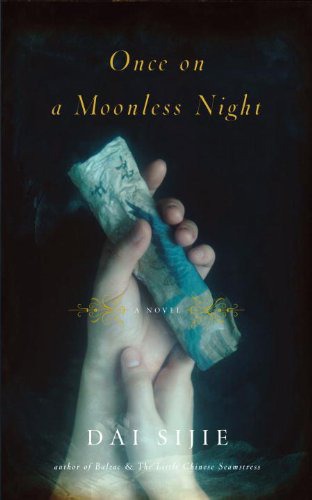
Once on a Moonless Night
- اطلاعات
- نقد و بررسی
- دیدگاه کاربران
نقد و بررسی

Starred review from June 29, 2009
Acclaimed novelist Sijie has written another novel that has already caused a stir in France. Narrated by an unnamed Western student in China in the 1970s, the story begins centuries before, with the Emperor Huizong, a calligrapher and great art collector, who acquired a silk scroll with a Buddhist sutra written upon it in an ancient lost language. The last emperor of Japan inherits the scroll and then in 1952, Paul d'Ampère, a French linguist, becomes obsessed with translating the scroll and goes to prison for 25 years for illegally acquiring it. When the narrator falls in love with a greengrocer, Tumchooq, who tells her the story, she begins to witness the life-altering consequences of the scroll—consequences that will change her own life and send her on a journey to seek truth and understanding. Sijie's breathtaking story shows the beauty and horrors that make up China's history while the poetry of Sijie's words is revealed in Hunter's magnificent translation. It's fitting that a story of a love affair with language should be written so beautifully.

June 15, 2009
A scroll containing a Buddhist sutra written in an unknown language causes no end of trouble in Sijie's meandering novel (Mr. Muo's Travelling Couch, 2005, etc.).
The unnamed narrator, a French student of Chinese literature at the University of Peking, first hears of the mysterious sutra in 1978, when she is acting as a translator during a meeting about The Last Emperor. Puyi, the subject of that film, inherited the second- or third-century scroll, which resided in the collection of a 12th-century emperor—and anyone who thinks that description is opaque should try reading the longwinded account given to the narrator by an elderly Chinese historian. When Puyi was taken prisoner by the Japanese, the historian says, he tore the scroll in half and flung both halves from the plane. Now the narrator backtracks to describe her meeting with Tumchooq, a vegetable seller on a street near the university, whose name is also the name of the ancient language in which the Buddhist scroll was written. Paul d'Amp're, the French scholar who figured this out in 1952, just happens to be Tumchooq's father; indeed, he may have married Tumchooq's mother, now a curator at the museum of the Forbidden City, to get his hands on the half of the scroll that her elderly relative picked up after it was flung from the plane. D'Amp're ends up in prison; his death there a quarter-century later sends Tumchooq into self-imposed exile. The narrator aborts his baby and returns to France, but soon she's learning new languages and traveling again, for no discernable reason except to make sure that she picks up Tumchooq's trail again in Burma in 1990. He's still looking for the complete text of the sutra, but the missing portion won't surface until after Tumchooq has been arrested and deported to Laos. By then, only the most patient readers will care.
Intended to celebrate the art of storytelling, this tedious work merely illustrates the perils of authorial self-indulgence.
(COPYRIGHT (2009) KIRKUS REVIEWS/NIELSEN BUSINESS MEDIA, INC. ALL RIGHTS RESERVED.)

Starred review from May 1, 2009
"Once on a moonless night a lone man is traveling]" and, stumbling, clings to the side of an abyss. No, this doesn't actually happen in Dai's magisterial new work; it's reputedly the beginning of a lost Buddhist sutra, written on a scrap of silk belonging to China's last emperor. As Dai would have it, the exiled emperor tosses it from a plane, and the daughter of the man who claims it is pursued by French linguist Paul d'Amperehe's fascinated because the sutra is written in the lost language of Tumchooq. Their son, named Tumchooq, keeps the story of the sutra alive and shares it with a Western student who becomes obsessed with itand pregnant with Tumchooq's child. Dai's latest is structurally more complex than his international hit, "Balzac and the Little Chinese Seamstress", whose power lies partly in its singular clarity. But it's just as rich and evocative and powerfully delivers the idea that language (even more than literature, as in "Balzac") truly defines us. This should be almost as big as "Balzac"; highly recommended. [See Prepub Alert, "LJ" 4/1/08.]Barbara Hoffert, "Library Journal"
Copyright 2009 Library Journal, LLC Used with permission.

Starred review from June 1, 2009
The spell cast by Dai Sijies novels, beginning with his bestselling Balzac and the Little Chinese Seamstress (2001), is attributable, in part, to his work as a filmmaker (his fiction is strikingly visual) and his bicultural and bilingual experiences. Sijie left China for France at age 30 in 1984. The unnamed narrator in his third bewitching novel, a French college student, makes the reverse trip. Inspired by Paul DAmpere, a gifted French linguist who retraced the steps of Marco Polo and then disappeared, she goes to Peking to study Chinese in 1978, learns about a long-missing ancient Buddhist scroll, and falls in love with Tumchooq, who is named after the language in which Buddha preached. Tumchooqs connection to DAmpere and the lost Buddhist sutra is slowly revealed within a finely embroidered sequence of flashbacks and testimonies. As impressionistically historical as it is imaginative, Dais dreamlike tale of epic quests and love put to the test is exquisitely structured to illuminate Hell, the earthly world, and Paradise within the Forbidden City, a Chinese prison camp, Paris, Mali, and Burma. Sijies dazzling and magical saga intimates that language is transcendent; books are precious; translation is a noble art; stories are the key to freedom; and truth prevails.(Reprinted with permission of Booklist, copyright 2009, American Library Association.)




دیدگاه کاربران